tow Alfa Romeo 147 2005 Owner handbook (in English)
[x] Cancel search | Manufacturer: ALFA ROMEO, Model Year: 2005, Model line: 147, Model: Alfa Romeo 147 2005Pages: 291, PDF Size: 5.52 MB
Page 102 of 291
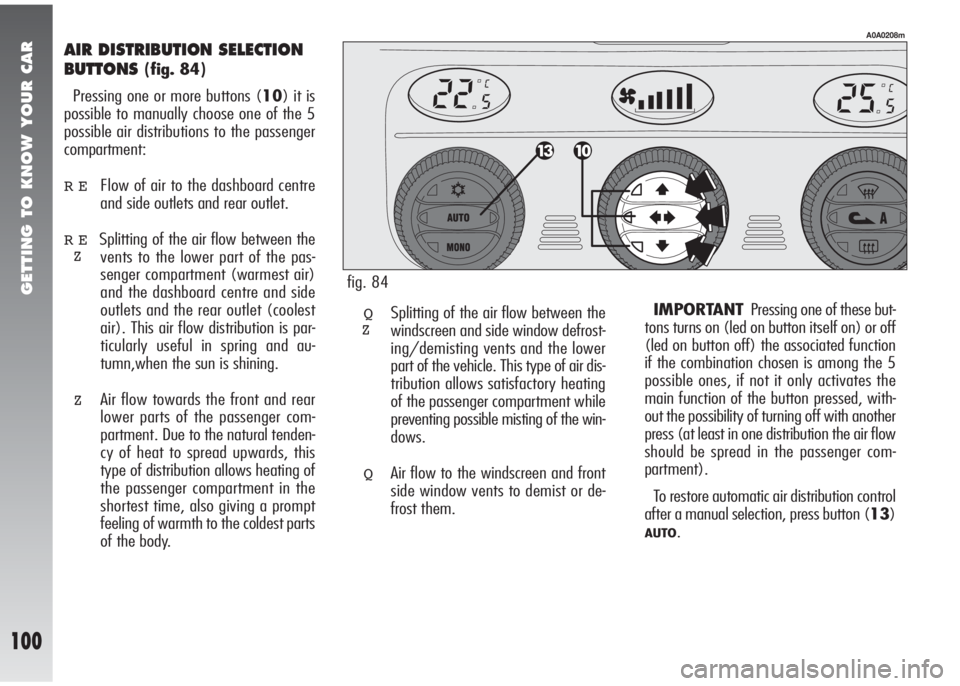
GETTING TO KNOW YOUR CAR
100
AIR DISTRIBUTION SELECTION
BUTTONS
(fig. 84)
Pressing one or more buttons (10) it is
possible to manually choose one of the 5
possible air distributions to the passenger
compartment:
REFlow of air to the dashboard centre
and side outlets and rear outlet.
RESplitting of the air flow between the
vents to the lower part of the pas-
senger compartment (warmest air)
and the dashboard centre and side
outlets and the rear outlet (coolest
air). This air flow distribution is par-
ticularly useful in spring and au-
tumn,when the sun is shining.
ZAir flow towards the front and rear
lower parts of the passenger com-
partment. Due to the natural tenden-
cy of heat to spread upwards, this
type of distribution allows heating of
the passenger compartment in the
shortest time, also giving a prompt
feeling of warmth to the coldest parts
of the body.
A0A0208m
QSplitting of the air flow between the
windscreen and side window defrost-
ing/demisting vents and the lower
part of the vehicle. This type of air dis-
tribution allows satisfactory heating
of the passenger compartment while
preventing possible misting of the win-
dows.
QAir flow to the windscreen and front
side window vents to demist or de-
frost them.IMPORTANTPressing one of these but-
tons turns on (led on button itself on) or off
(led on button off) the associated function
if the combination chosen is among the 5
possible ones, if not it only activates the
main function of the button pressed, with-
out the possibility of turning off with another
press (at least in one distribution the air flow
should be spread in the passenger com-
partment).
To restore automatic air distribution control
after a manual selection, press button (13)
AUTO.
Z
Z
fig. 84
Page 106 of 291

GETTING TO KNOW YOUR CAR
104
QUICK FRONT WINDOW
DEMISTING/DEFROSTING
BUTTON
(-MAX-DEFfunction)(fig. 89)
Pressing button (7)
-the climate con-
trol automatically activates timed operation
of all the functions needed to quicken
demisting/defrosting of the windscreen and
front side windows, i.e.:
- it turns on the climate control compres-
sor;
- switches off inside air re-circulation, if on
(both leds off);
- sets the maximum air temperature (HI)
on both displays (1) and (5);
- operates the fan at a predefined speed;
- directs the flow of air towards the wind-
screen and front side window vents;
- turns on rearscreen heating and, if pre-
sent, the wing mirror coils.
When the maximum demisting/defrosting
feature is on, the led on button (7)
-, the
led on the rearscreen heating button (9)
(and the led on button (14)√turn on;
at the same time the leds on button (8)
vgo off.IMPORTANTIf the engine is not warm
enough, the function will not engage the
predefined fan speed immediately, to limit
the flow to the passenger compartment of
air that is not warm enough to demist the
windows.
When the maximum demisting/defrost-
ing function is on, the only manual opera-
tions possible are manual adjustment of the
fan and switching rearscreen heating off.Pressing one of the following buttons
again: (7)
-, (8)v, (12)MONO,
(13)
AUTOor (14)√the system switch-
es off the maximum demisting/defrosting
function, restoring the operating conditions
of the system prior to turning it on, in ad-
dition to activating the last function required,
if any.
A0A0213m
fig. 89
Page 110 of 291

GETTING TO KNOW YOUR CAR
108
HAND BRAKE (fig. 94)
The hand brake lever is located between
the two front seats.
To operate the brake when the vehicle is
stationary, pull lever (A) upwards, until the
required braking action is obtained.
When the ignition key is at MARthe
warning light on the instrument cluster
x
will come on.
fig. 94
A0A0490m
The display (B), in the tachometer shows
the positions during adjustment.
For correct adjustment, bear in mind the
following conditions:
– position 0: one or two people occupy-
ing the front seats
– position 1: five people;
– position 2: five people + load in the
boot;
– position 3: driver + maximum permis-
sible load all stowed in lug-
gage compartment
fig. 93
A0A0467m
HEADLIGHT AIMING DEVICE
(fig. 93)(excluding versions
with Xenon headlights)
The headlights should be aimed correctly
depending on the vehicle load.
To do this, use the rocker button (A), on
the plate at the side of the steering column:
– press the arrow on the button (
A), to
increase by one position (eg.: 0
➟1➟ 2
➟3);
– press the arrow on the button (
S), to
lower by one position (eg.: 3
➟2➟1
➟0).
Adjust the beams every time
the load carried changes.
WARNING
The wheels should be
locked after a few clicks of
the hand brake. If this does not oc-
cur contact Alfa Romeo Authorised
services to have the hand brake
adjusted.
WARNING
Page 120 of 291
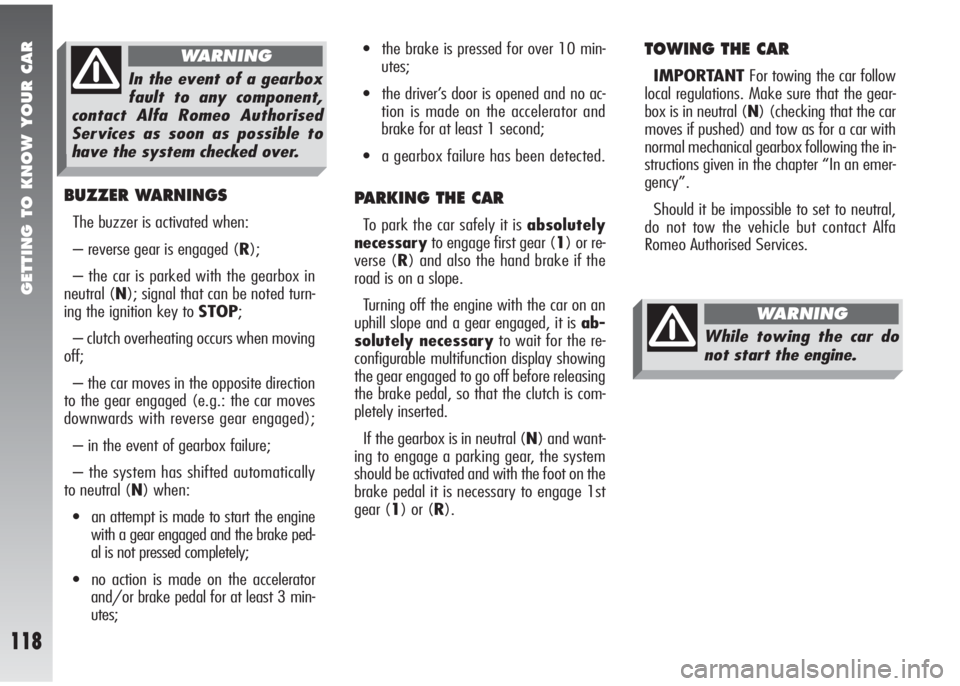
GETTING TO KNOW YOUR CAR
118
BUZZER WARNINGS
The buzzer is activated when:
– reverse gear is engaged (R);
– the car is parked with the gearbox in
neutral (N); signal that can be noted turn-
ing the ignition key to STOP;
– clutch overheating occurs when moving
off;
– the car moves in the opposite direction
to the gear engaged (e.g.: the car moves
downwards with reverse gear engaged);
– in the event of gearbox failure;
– the system has shifted automatically
to neutral (N) when:
•an attempt is made to start the engine
with a gear engaged and the brake ped-
al is not pressed completely;
•no action is made on the accelerator
and/or brake pedal for at least 3 min-
utes;
•the brake is pressed for over 10 min-
utes;
•the driver’s door is opened and no ac-
tion is made on the accelerator and
brake for at least 1 second;
•a gearbox failure has been detected.
PARKING THE CAR
To park the car safely it is absolutely
necessaryto engage first gear (1) or re-
verse (R) and also the hand brake if the
road is on a slope.
Turning off the engine with the car on an
uphill slope and a gear engaged, it is ab-
solutely necessaryto wait for the re-
configurable multifunction display showing
the gear engaged to go off before releasing
the brake pedal, so that the clutch is com-
pletely inserted.
If the gearbox is in neutral (N) and want-
ing to engage a parking gear, the system
should be activated and with the foot on the
brake pedal it is necessary to engage 1st
gear (1) or (R).
TOWING THE CAR
IMPORTANTFor towing the car follow
local regulations. Make sure that the gear-
box is in neutral (N) (checking that the car
moves if pushed) and tow as for a car with
normal mechanical gearbox following the in-
structions given in the chapter “In an emer-
gency”.
Should it be impossible to set to neutral,
do not tow the vehicle but contact Alfa
Romeo Authorised Services.
While towing the car do
not start the engine.
WARNING
In the event of a gearbox
fault to any component,
contact Alfa Romeo Authorised
Services as soon as possible to
have the system checked over.
WARNING
Page 134 of 291

GETTING TO KNOW YOUR CAR
132fig. 135
A0A0199m
For correct adjustment, bear in mind the
following conditions:
– position 0: one or two people occupy-
ing the front seats
– position 1: five people;
– position 2: five people + load in the
boot;
– position 3: driver + maximum permis-
sible load all stowed in lug-
gage compartmentCOMPENSATION FOR TILT
(fig. 134)(excluding versions
with Xenon headlights)
When the vehicle is loaded, the beam from
the headlights is raised due to the back-
wards tilt of the vehicle.
In this case the headlights must be ad-
justed correctly.
To do this, use the rocker button (A), on
the plate at the side of the steering column:
– press the arrow on the button (
A), this
will increase by one position (eg.: 0
➟1
➟ 2➟3);
– press the arrow on the button (
S), this
will lower by one position (eg.: 3
➟2➟
1➟0);
The display (B), in the tachometer shows
the positions while adjustment is being
made.
fig. 134
A0A0467m
HEADLIGHTS
The adjustment of the headlights is vital to
your safety and comfort and to that of oth-
er road users.
The adjustment of the headlights is also
governed by precise regulations.
Contact Alfa Romeo Authorised Services to
have the headlights correctly adjusted.
IMPORTANTOn the inside surface of
the headlight there could appear a slight
coat of fogging; this does not show a defect,
since it is a natural occurrence due to low
temperature and to the degree of humidity
in the air; it will soon disappear as soon as
the lights are turned on. The presence of
drops inside the headlight shows water seep-
age, refer to the Alfa Romeo Dealership.
Check beam aiming every
time the load carried
changes.
WARNING
Page 179 of 291

CORRECT USE OF THE CAR
177
EMERGENCY STARTING
If the Alfa Romeo CODE system does not
recognise the code transmitted by the igni-
tion key (
Y)warning light on the instru-
ment cluster on glowing steadily) emer-
gency starting may be carried out using the
code of the CODE card.
For the correct procedure see the chapter
“In an emergency”.
PARKING
When the vehicle is parked, proceed as fol-
lows:
– Switch off the engine.
– Engage the handbrake.
– Engage first gear if the vehicle is fac-
ing uphill or reverse if the vehicle is facing
downhill.
– Turn the front wheels so that the vehi-
cle will immediately come to a halt if the
handbrake slips. Never bump, tow, or
coast start the vehicle as
this would cause fuel to
flow into the catalyst causing irre-
versible damage.
To avoid useless con-
sumption of power and
possibly draining the bat-
tery, never leave the ignition key
in the MAR position when the en-
gine is not running.
Sharp accelerating before
switching the engine off
should be avoided. A
“kick” on the accelerator serves
no purposes and consumes fuel
pointlessly.
IMPORTANT
If the engine turns off with
the vehicle on the move, the next time it
is started, the Alfa Romeo CODE warning
light may turn on (
Y). In this case, check
that switching off and starting the engine
again with the vehicle stationary, the warn-
ing light stays off. If not, contact Alfa Romeo
Authorised Services.
Remember that the servo-
brake and power steering
are not operational until the engine
has been started, therefore much
more effort than usual is required
on the brake pedal and steering
wheel.
WARNING
Never leave children unat-
tended in the vehicle. Al-
ways remove the ignition key
when leaving the vehicle and take
it with you.
WARNING
Page 186 of 291
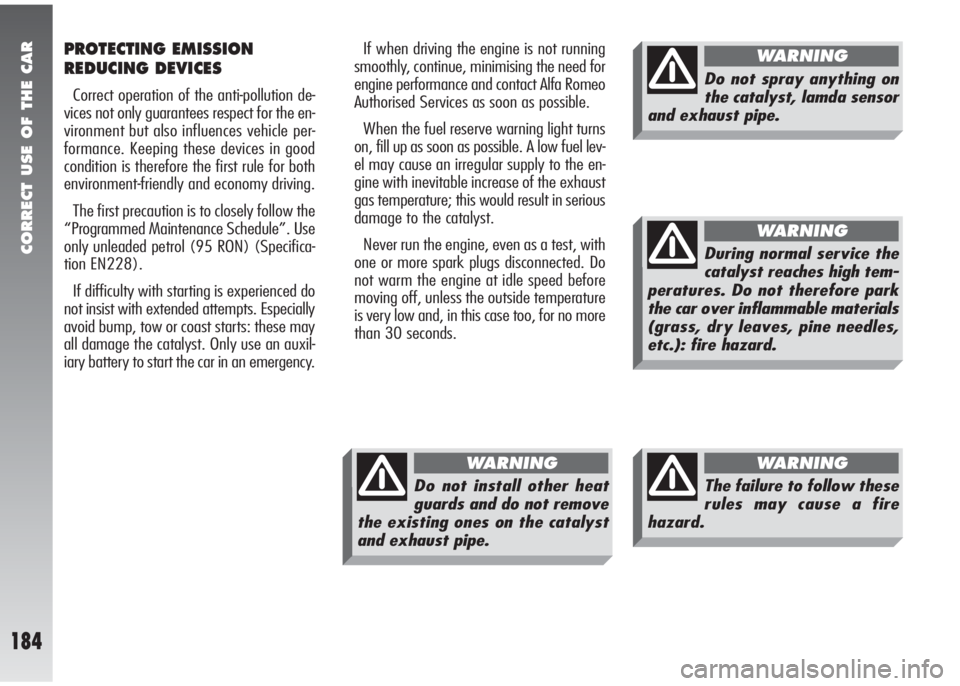
CORRECT USE OF THE CAR
184
PROTECTING EMISSION
REDUCING DEVICES
Correct operation of the anti-pollution de-
vices not only guarantees respect for the en-
vironment but also influences vehicle per-
formance. Keeping these devices in good
condition is therefore the first rule for both
environment-friendly and economy driving.
The first precaution is to closely follow the
“Programmed Maintenance Schedule”. Use
only unleaded petrol (95 RON) (Specifica-
tion EN228).
If difficulty with starting is experienced do
not insist with extended attempts. Especially
avoid bump, tow or coast starts: these may
all damage the catalyst. Only use an auxil-
iary battery to start the car in an emergency.If when driving the engine is not running
smoothly, continue, minimising the need for
engine performance and contact Alfa Romeo
Authorised Services as soon as possible.
When the fuel reserve warning light turns
on, fill up as soon as possible. A low fuel lev-
el may cause an irregular supply to the en-
gine with inevitable increase of the exhaust
gas temperature; this would result in serious
damage to the catalyst.
Never run the engine, even as a test, with
one or more spark plugs disconnected. Do
not warm the engine at idle speed before
moving off, unless the outside temperature
is very low and, in this case too, for no more
than 30 seconds.
Do not spray anything on
the catalyst, lamda sensor
and exhaust pipe.
WARNING
The failure to follow these
rules may cause a fire
hazard.
WARNING
Do not install other heat
guards and do not remove
the existing ones on the catalyst
and exhaust pipe.
WARNING
During normal service the
catalyst reaches high tem-
peratures. Do not therefore park
the car over inflammable materials
(grass, dry leaves, pine needles,
etc.): fire hazard.
WARNING
Page 187 of 291
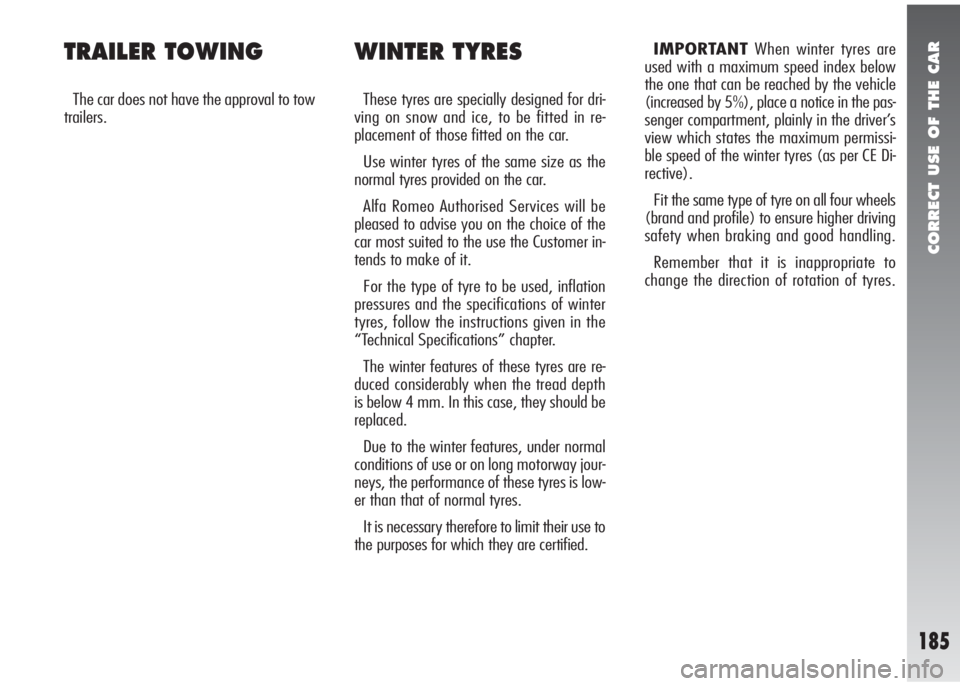
CORRECT USE OF THE CAR
185
IMPORTANTWhen winter tyres are
used with a maximum speed index below
the one that can be reached by the vehicle
(increased by 5%), place a notice in the pas-
senger compartment, plainly in the driver’s
view which states the maximum permissi-
ble speed of the winter tyres (as per CE Di-
rective).
Fit the same type of tyre on all four wheels
(brand and profile) to ensure higher driving
safety when braking and good handling.
Remember that it is inappropriate to
change the direction of rotation of tyres. WINTER TYRES
These tyres are specially designed for dri-
ving on snow and ice, to be fitted in re-
placement of those fitted on the car.
Use winter tyres of the same size as the
normal tyres provided on the car.
Alfa Romeo Authorised Services will be
pleased to advise you on the choice of the
car most suited to the use the Customer in-
tends to make of it.
For the type of tyre to be used, inflation
pressures and the specifications of winter
tyres, follow the instructions given in the
“Technical Specifications” chapter.
The winter features of these tyres are re-
duced considerably when the tread depth
is below 4 mm. In this case, they should be
replaced.
Due to the winter features, under normal
conditions of use or on long motorway jour-
neys, the performance of these tyres is low-
er than that of normal tyres.
It is necessary therefore to limit their use to
the purposes for which they are certified.
TRAILER TOWING
The car does not have the approval to tow
trailers.
Page 189 of 291
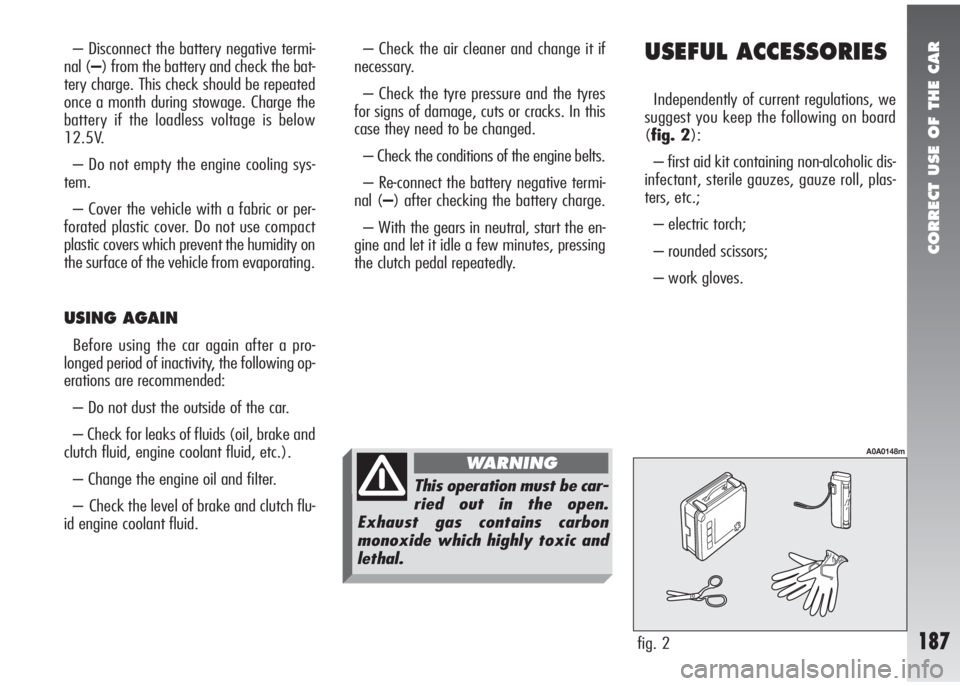
CORRECT USE OF THE CAR
187
USEFUL ACCESSORIES
Independently of current regulations, we
suggest you keep the following on board
(fig. 2):
– first aid kit containing non-alcoholic dis-
infectant, sterile gauzes, gauze roll, plas-
ters, etc.;
– electric torch;
– rounded scissors;
– work gloves.
fig. 2
A0A0148m
– Disconnect the battery negative termi-
nal (–) from the battery and check the bat-
tery charge. This check should be repeated
once a month during stowage. Charge the
battery if the loadless voltage is below
12.5V.
– Do not empty the engine cooling sys-
tem.
– Cover the vehicle with a fabric or per-
forated plastic cover. Do not use compact
plastic covers which prevent the humidity on
the surface of the vehicle from evaporating.
USING AGAIN
Before using the car again after a pro-
longed period of inactivity, the following op-
erations are recommended:
– Do not dust the outside of the car.
– Check for leaks of fluids (oil, brake and
clutch fluid, engine coolant fluid, etc.).
– Change the engine oil and filter.
– Check the level of brake and clutch flu-
id engine coolant fluid.– Check the air cleaner and change it if
necessary.
– Check the tyre pressure and the tyres
for signs of damage, cuts or cracks. In this
case they need to be changed.
– Check the conditions of the engine belts.
– Re-connect the battery negative termi-
nal (–) after checking the battery charge.
– With the gears in neutral, start the en-
gine and let it idle a few minutes, pressing
the clutch pedal repeatedly.
This operation must be car-
ried out in the open.
Exhaust gas contains carbon
monoxide which highly toxic and
lethal.
WARNING
Page 192 of 291
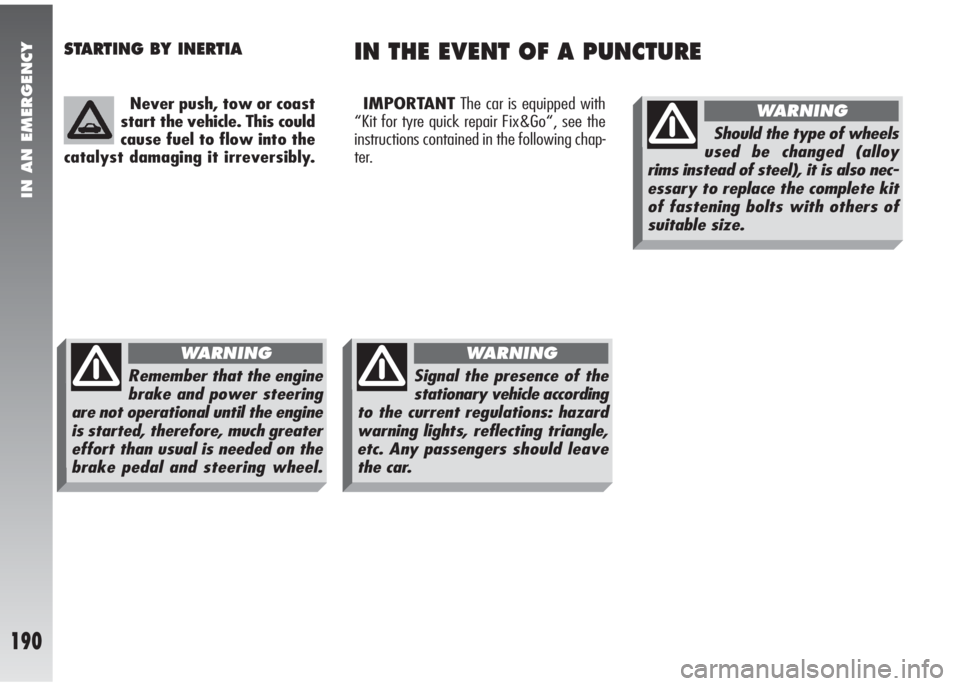
IN AN EMERGENCY
190
IMPORTANTThe car is equipped with
“Kit for tyre quick repair Fix&Go“, see the
instructions contained in the following chap-
ter.
STARTING BY INERTIAIN THE EVENT OF A PUNCTURE
Never push, tow or coast
start the vehicle. This could
cause fuel to flow into the
catalyst damaging it irreversibly.
Remember that the engine
brake and power steering
are not operational until the engine
is started, therefore, much greater
effort than usual is needed on the
brake pedal and steering wheel.
WARNING
Signal the presence of the
stationary vehicle according
to the current regulations: hazard
warning lights, reflecting triangle,
etc. Any passengersshould leave
the car.
WARNING
Should the type of wheels
used be changed (alloy
rims instead of steel), it is also nec-
essary to replace the complete kit
of fastening bolts with others of
suitable size.
WARNING